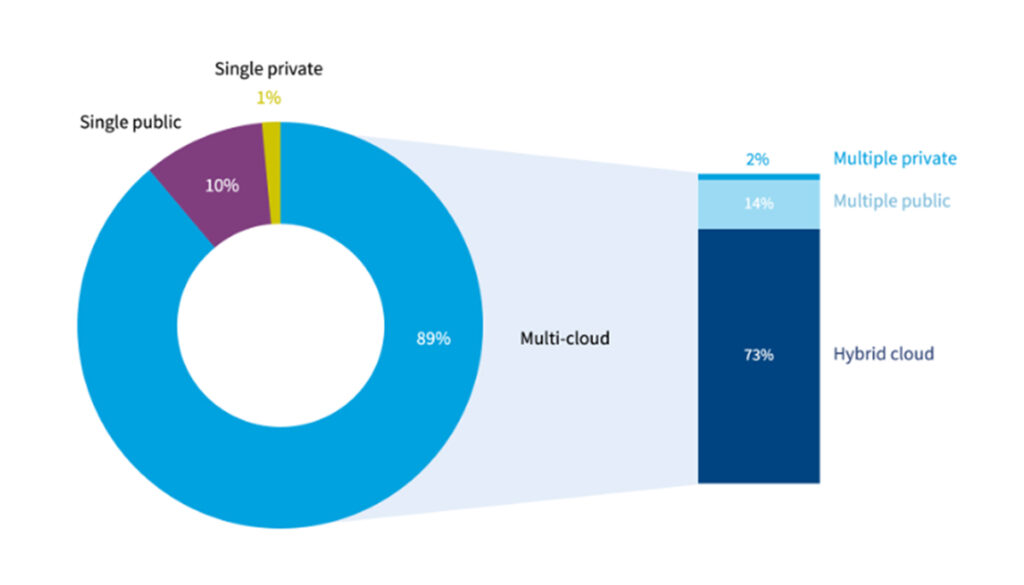In 2024, digitalization has positioned itself at the center of corporate strategies in Ecuador, being key to drive scalability and productivity in the business environment. According to the Flexera 2024 report, the use of the cloud plays a crucial role in this process, with 89% of cloud users worldwide preferring to adopt hybrid or multi-cloud models, as they provide computing environments that are not only optimal, but also flexible and adaptable, thus meeting the changing needs of businesses.
The digital cloud represents an ecosystem that distributes IT resources over the Internet, and operates under a pay-per-use model. This allows users to access services such as storage capacity and database management according to their needs. According to Boris Monsalve, Vice President of Kruger Corporation, the cloud is a fundamental part of the digital infinite, offering unlimited access to resources that facilitate the optimization and digitization of processes. In this context, the cloud has become an ideal platform that not only guarantees innovation and operability, but also promotes flexibility and effective integration of work teams.

While migration to the cloud brings significant challenges for enterprises, such as data security, storage capacity, technical complexity and regulatory compliance, there are effective solutions to overcome these difficulties in a secure and efficient manner, thus maximizing the benefits of this technology.
Experts in cloud integration ecosystems, from renowned companies such as IBM, Prisma by Palo Alto and Amazon AWS, highlight the benefits of adopting strategies such as Well-Architected Framework, FinOps, Cloud Security and Observability. They not only improve infrastructure and resource management, but also optimize the performance and security that companies require in their operations.
Pedro Camacho, IBM Solution Architect and Partner, highlights the importance of observability in cloud environments, especially when integrated with AI artificial intelligence. This combination enables automatic anomaly detection through real-time data analysis, identifying unusual behaviors that could result in failures. At the same time, it optimizes the management of future incident response, thus improving the overall view of performance, safety and resource utilization.
On the other hand, Edwin Romero, Solution Architect at AWS, underlines the importance of the Well-Architected Framework as an essential practice to optimize the workload and bring greater benefits to the company. In turn, Luis Castro, Partner at Palo Alto by Prisma, highlights the current need for platforms that provide security in cloud and multi-cloud environments. In a context where data vulnerability has increased significantly, Castro argues that only a transformation to cloud-based solutions can mitigate these risks.
In the digital era, the cloud is emerging as an indispensable resource for organizations. Its implementation not only improves efficiency and safety, but also fosters innovation and resource optimization. Thus, the comprehensive benefits offered by the cloud include:
- Operational Efficiency (FinOps): The use of the cloud optimizes infrastructure and service utility on demand, allowing companies to manage, reduce and control their operating expenses, generating trust between product owners and FinOps team.
- Scalability (Well Architecture): The cloud together with IA allows companies to use their services dynamically without large investments in hardware, optimizing the use of technological resources and guaranteeing an efficient architecture.
- Security: The cloud offers greater cybersecurity, from data encryption to the operation of processes, since diversifying the location of stored information minimizes the risk of vulnerability.
- Accelerated Innovation: Access to advanced cloud technologies enables companies to innovate quickly, facilitating experimentation and the launch of new solutions.
- Cloud Governance: Companies can visualize, measure and control their operations from anywhere through the set of tools offered by the cloud to ensure operability and observability.
Companies that strategically implement cloud solutions not only experience significant gains in agility and operational efficiency, but also gain access to cutting-edge technologies that drive growth and strengthen their competitiveness in the marketplace. According to projections by the International Data Corporation (IDC), between 2024 and 2025, the adoption rate of cloud technologies is expected to grow by 31.9% over the previous year, underscoring an upward trend in the integration of these solutions globally. This continued growth in cloud adoption and its obvious benefits for business efficiency and competitiveness highlight the importance of considering its implementation to stay relevant in an ever-evolving market.


